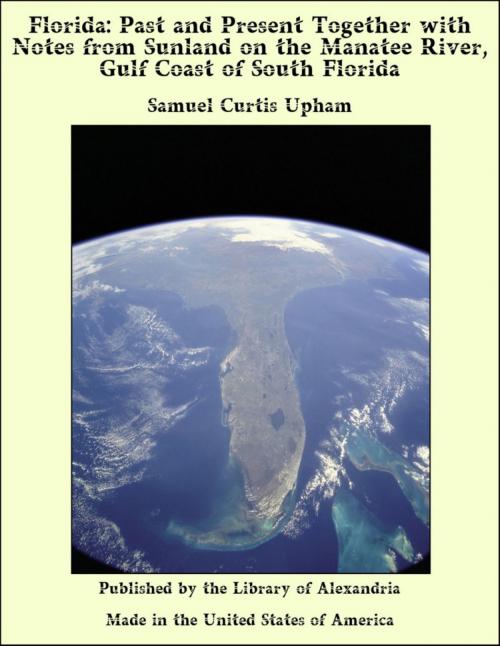Florida: Past and Present Together with Notes from Sunland on the Manatee River, Gulf Coast of South Florida
Nonfiction, Religion & Spirituality, New Age, History, Fiction & Literature| Author: | Samuel Curtis Upham | ISBN: | 9781465595102 |
| Publisher: | Library of Alexandria | Publication: | March 8, 2015 |
| Imprint: | Language: | English |
| Author: | Samuel Curtis Upham |
| ISBN: | 9781465595102 |
| Publisher: | Library of Alexandria |
| Publication: | March 8, 2015 |
| Imprint: | |
| Language: | English |
THIRTY years ago the word Florida was synonymous with mosquitoes, alligators, snakes, and Indians. As a part of this Union, it was at that time considered financially a worthless sand-spit, which had cost our Government fifty million dollars and many lives in the almost fruitless effort to rescue it from the hands of the wily Creeks and Seminoles, who occupied the middle and southern portions of the State. From the date of Dade’s massacre by Osceola’s band near Brooksville, in December, 1835, which sent a thrill of horror throughout the length and breadth of our land, to the surrender of Billy Bowlegs in 1858, a period of nearly twenty-five years, war was waged by our Government under the leadership of Generals Worth, Scott, Harney, Taylor, and their subordinates, with the result above stated. In order to fully understand and appreciate the present condition of Florida, some little knowledge of her history is indispensable; for without such knowledge, the sparseness of the present population of the State is inexplicable, when taken in connection with its genial climate, its natural fertility, and the immense scope of its possible agricultural production. “If Florida possesses so great a variety and power of vegetable growth, and such a desirable climate, why is it not more densely populated?” is a question answered only by a glance at her past history. The honor due to the first discovery of the land which now constitutes the southern extremity of the United States is generally awarded to that famous and eccentric old Spanish adventurer, Juan Ponce de Leon. Nevertheless, the validity of his claim to that honor is liable to some dispute. Several authorities of very good credit maintain that Sebastian Cabot, in the year 1497, traced the whole line of the American coast as far southward as 36° 9´ north latitude; and Peter Martyr avers that he sailed to the west of the meridian of Cuba. From this account it does not appear that Cabot proceeded further southward than the mouth of the Chesapeake Bay, the latitude of which corresponds nearly with that of the Straits of Gibraltar, and the longitude with that of the eastern extremity of Cuba. It can scarcely be doubted that Ponce de Leon was the first European who landed on any part of that ground which is now occupied by the Southern States of our Republic. The purpose for which he visited this country has exposed his memory to no little ridicule; but his childish delusion is entitled to more indulgence and respect than the sordid and hypocritical motives which induced so many of his countrymen to become explorers and crusaders in America. Juan Ponce, for the purpose of discovering the location of the “Fountain of Youth,” set sail from Porto Rico, on the 3d day of March, 1512. After a short voyage he came to a country covered with flowers and verdure, and as the day of his discovery happened to be Palm Sunday, called by the Spaniards Pasqua Florida, he bestowed the name of Florida on the country in commemoration of this circumstance. Thus the first European discovery of Florida took place on the second day of April, 1512. The next visit to Florida by Europeans was made in the year 1520, by Lucas Vasquez de Ayllon, who kidnapped one hundred and thirty Indians and sailed for San Domingo, where he sold them as slaves. In the year 1524, Giovanni da Verazzano, a Florentine sea-captain in the service of the French Government, coasted from Florida as high as Cape Breton.
THIRTY years ago the word Florida was synonymous with mosquitoes, alligators, snakes, and Indians. As a part of this Union, it was at that time considered financially a worthless sand-spit, which had cost our Government fifty million dollars and many lives in the almost fruitless effort to rescue it from the hands of the wily Creeks and Seminoles, who occupied the middle and southern portions of the State. From the date of Dade’s massacre by Osceola’s band near Brooksville, in December, 1835, which sent a thrill of horror throughout the length and breadth of our land, to the surrender of Billy Bowlegs in 1858, a period of nearly twenty-five years, war was waged by our Government under the leadership of Generals Worth, Scott, Harney, Taylor, and their subordinates, with the result above stated. In order to fully understand and appreciate the present condition of Florida, some little knowledge of her history is indispensable; for without such knowledge, the sparseness of the present population of the State is inexplicable, when taken in connection with its genial climate, its natural fertility, and the immense scope of its possible agricultural production. “If Florida possesses so great a variety and power of vegetable growth, and such a desirable climate, why is it not more densely populated?” is a question answered only by a glance at her past history. The honor due to the first discovery of the land which now constitutes the southern extremity of the United States is generally awarded to that famous and eccentric old Spanish adventurer, Juan Ponce de Leon. Nevertheless, the validity of his claim to that honor is liable to some dispute. Several authorities of very good credit maintain that Sebastian Cabot, in the year 1497, traced the whole line of the American coast as far southward as 36° 9´ north latitude; and Peter Martyr avers that he sailed to the west of the meridian of Cuba. From this account it does not appear that Cabot proceeded further southward than the mouth of the Chesapeake Bay, the latitude of which corresponds nearly with that of the Straits of Gibraltar, and the longitude with that of the eastern extremity of Cuba. It can scarcely be doubted that Ponce de Leon was the first European who landed on any part of that ground which is now occupied by the Southern States of our Republic. The purpose for which he visited this country has exposed his memory to no little ridicule; but his childish delusion is entitled to more indulgence and respect than the sordid and hypocritical motives which induced so many of his countrymen to become explorers and crusaders in America. Juan Ponce, for the purpose of discovering the location of the “Fountain of Youth,” set sail from Porto Rico, on the 3d day of March, 1512. After a short voyage he came to a country covered with flowers and verdure, and as the day of his discovery happened to be Palm Sunday, called by the Spaniards Pasqua Florida, he bestowed the name of Florida on the country in commemoration of this circumstance. Thus the first European discovery of Florida took place on the second day of April, 1512. The next visit to Florida by Europeans was made in the year 1520, by Lucas Vasquez de Ayllon, who kidnapped one hundred and thirty Indians and sailed for San Domingo, where he sold them as slaves. In the year 1524, Giovanni da Verazzano, a Florentine sea-captain in the service of the French Government, coasted from Florida as high as Cape Breton.















